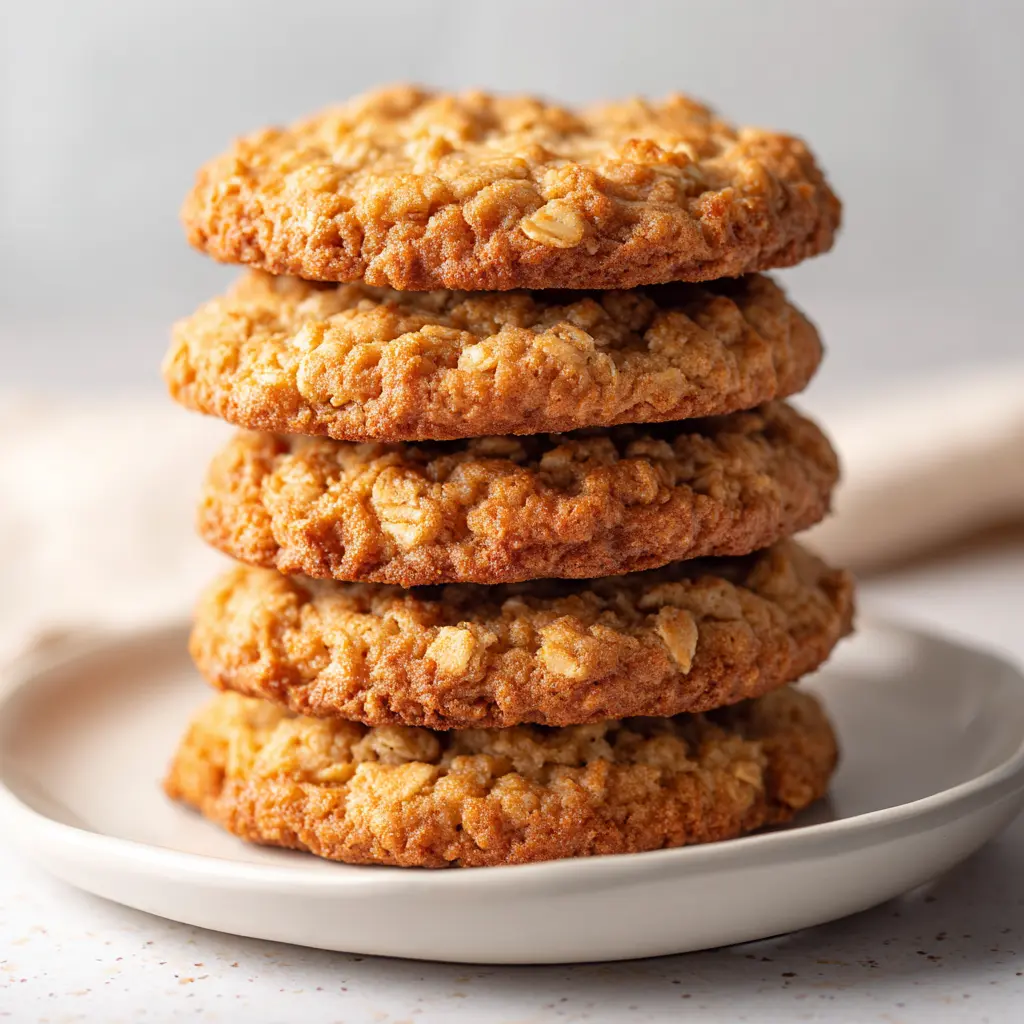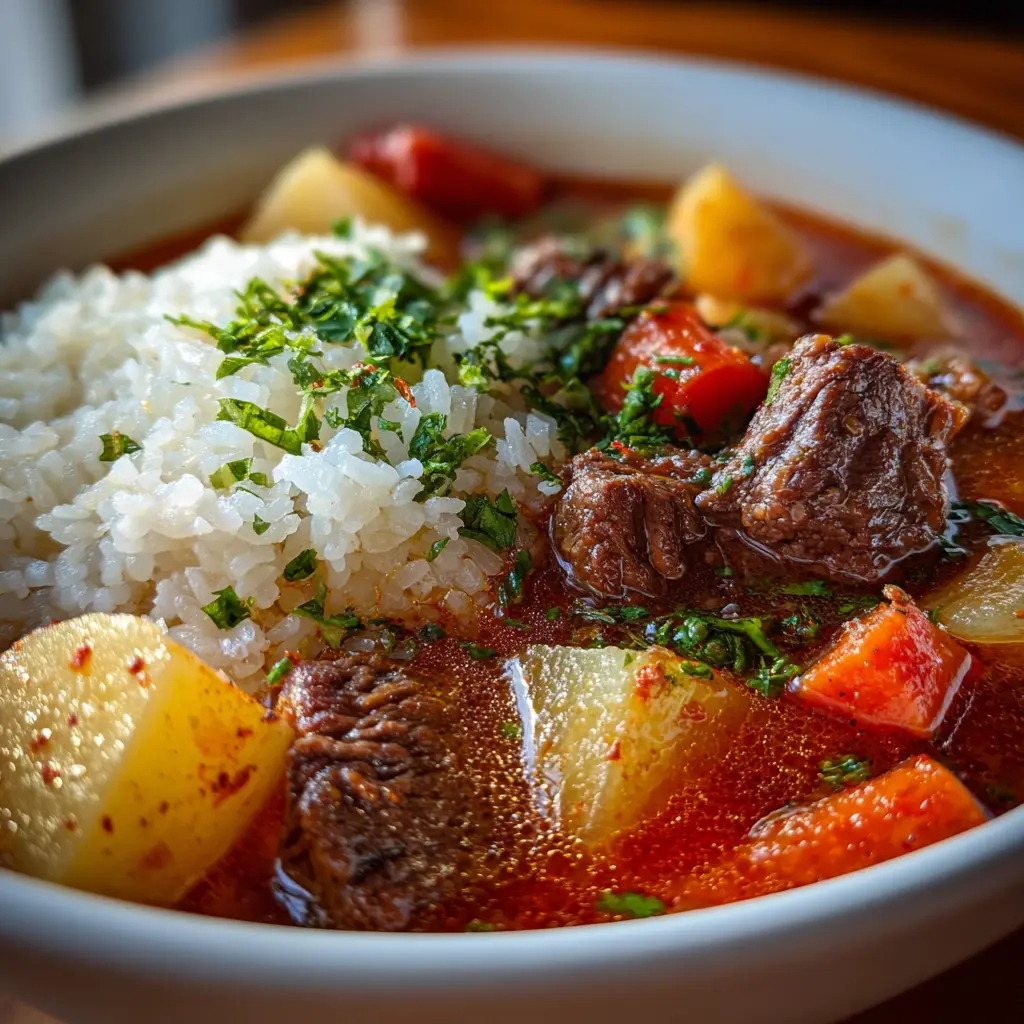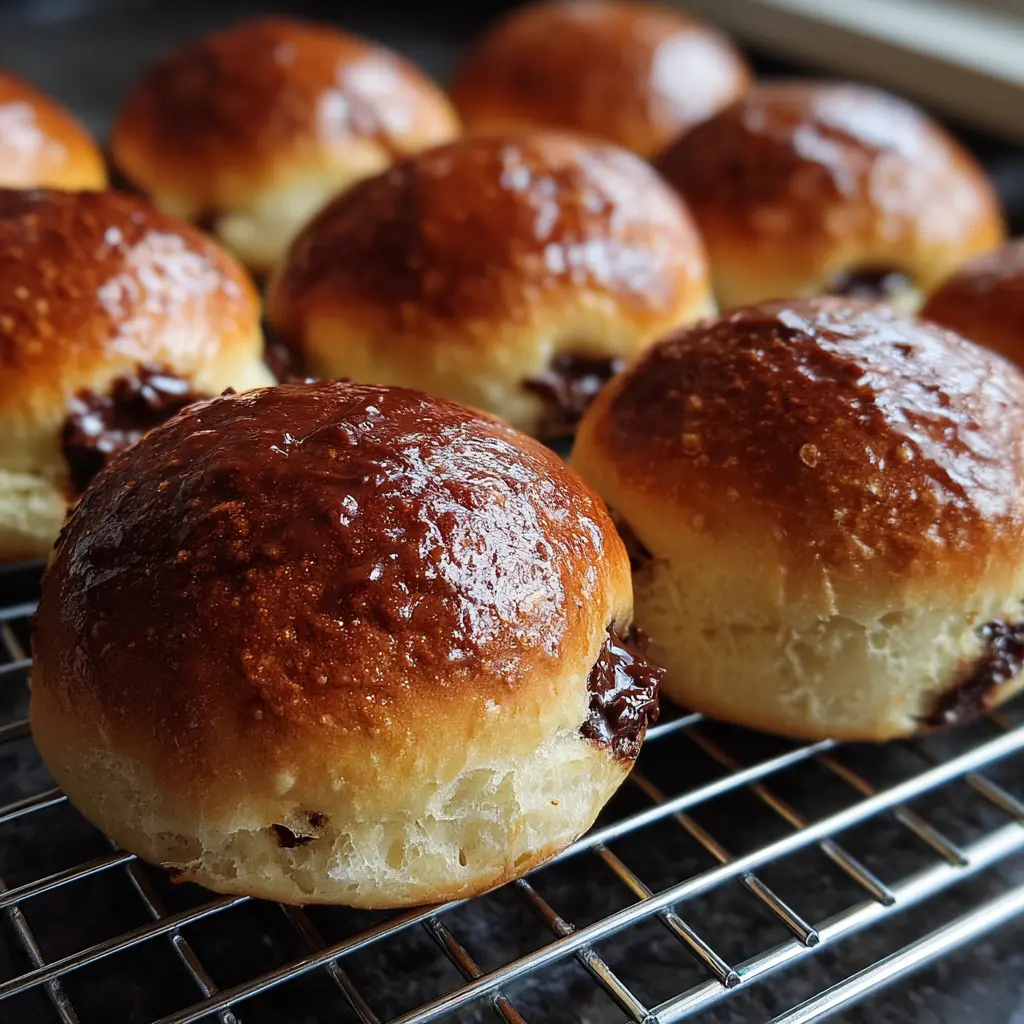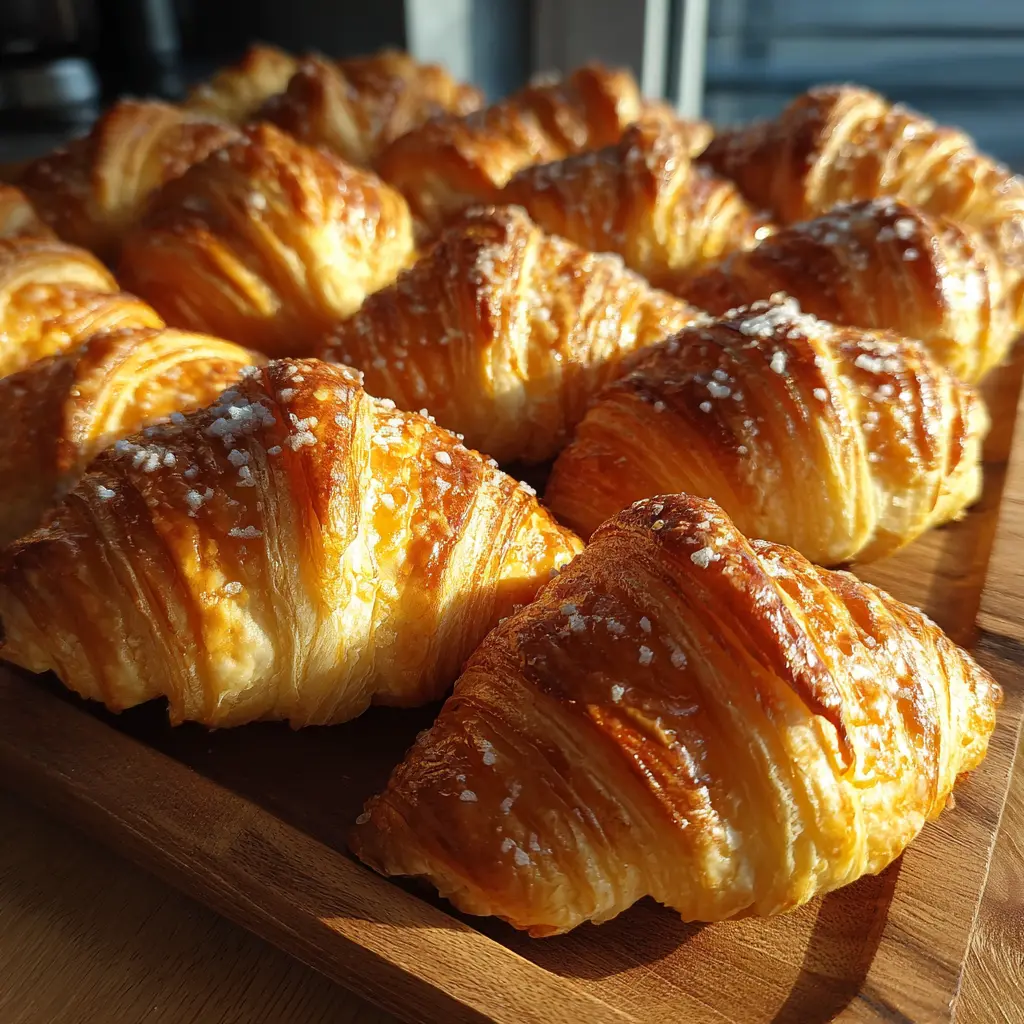The first tray of Chewy Oatmeal Cookies I ever baked didn’t just come out of the oven—it came alive in the kitchen. The air filled with the buttery sweetness of brown sugar and oats, the kind of smell that makes you stop mid-conversation and close your eyes just to savor it. When I broke one open, the edges gave a gentle snap, while the center stayed soft, warm, and perfectly chewy. That moment taught me something every baker learns sooner or later: cookies aren’t just desserts, they’re little stories told in sugar and spice.
As a chef, I’ve come to see that baking chewy oatmeal cookies isn’t only about mixing flour, oats, and butter. It’s about balance. Too much sugar and they spread too thin, too little fat and they turn dry. Even the type of oats or the way you chill the dough can be the difference between a cookie that crumbles and one that melts in your mouth.
In this guide, I’ll take you behind the scenes of what makes the best chewy oatmeal cookies. We’ll look at the science of chewiness, the role of butter versus shortening, how sugar choices affect texture, and the tricks bakers use to keep cookies soft for days. You’ll also find flavor variations, healthier twists, and solutions to common baking mishaps.
So whether you love them packed with raisins, studded with chocolate chips, or layered with toasted nuts, this is your roadmap to chewy cookie perfection.
And if you’d like a savory contrast for later, check out this rich and creamy Bagel Dip Recipe—a cozy kitchen pairing after dessert.
Understanding Chewy Oatmeal Cookies
The Timeless Appeal of Chewy Oatmeal Cookies
There’s a reason oatmeal cookies have never left the dessert table. Unlike sugar cookies that can feel too sweet or chocolate chip cookies that sometimes overshadow the dough with chocolate, oatmeal cookies strike a balance. The oats bring a nutty richness, the dough offers a comforting chew, and the add-ins—whether raisins, chocolate chips, or nuts—create endless variations.
As a chef, I often describe them as the cookie that listens to your mood. Want something classic? Go with plump raisins. Need indulgence? Stir in dark chocolate chunks. Craving crunch? Toasted walnuts or pecans will do the trick. But no matter the add-in, the base always comes down to mastering what makes a cookie chewy.
What Makes Chewy Oatmeal Cookies Different from Crunchy Ones
The difference between a chewy oatmeal cookie and a crunchy one comes down to science—and a little kitchen intuition. The texture depends on fat, sugar, moisture, and baking technique.
| Factor | Effect on Texture |
|---|---|
| Fat Content | More fat creates a chewier cookie; less fat makes it crisp. |
| Sugar Type | Brown sugar holds moisture for softness; white sugar dries and crisps. |
| Eggs & Moisture | Extra yolks or liquid sweeteners (honey, molasses) add tenderness. |
| Baking Temperature | Lower heat + longer baking = chewy centers. Higher heat = crispy edges. |
That’s why a recipe tweak as small as swapping half the white sugar for brown sugar, or adding an extra egg yolk, can transform a batch.
Why Oats Make the Difference
Here’s the truth: oats are the unsung hero of chewiness. Rolled oats give that hearty texture, while quick oats create a softer, denser cookie. Steel-cut oats, on the other hand, are too tough for baking and will leave you with unpleasant crunch.
As Harvard’s Nutrition Source highlights, oats are rich in beta-glucan, a soluble fiber that supports heart health and also contributes to the moist, chewy texture in oatmeal cookies.
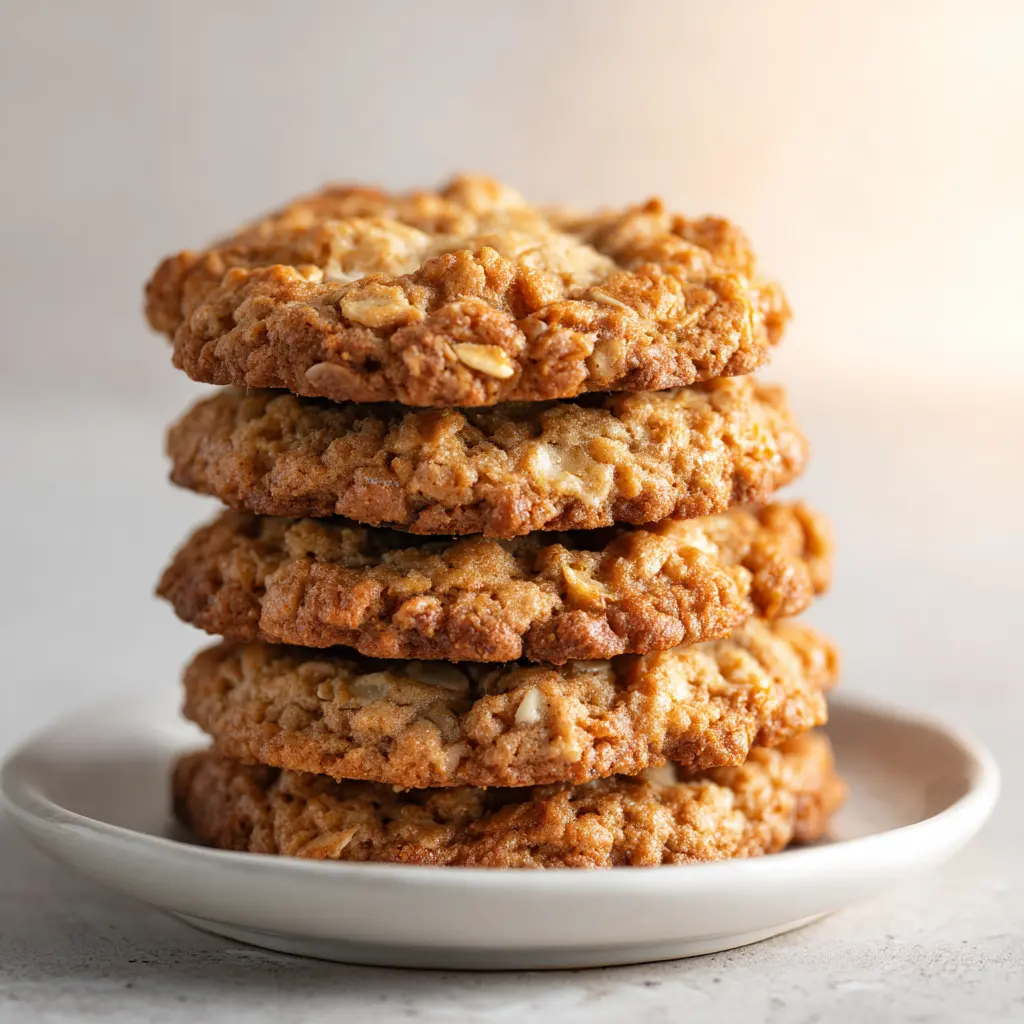
Chewy Oatmeal Cookies
Ingredients
Equipment
Method
- Preheat your oven to 350°F (175°C). Line a baking sheet with parchment paper or a silicone mat.
- Cream together the butter, brown sugar, and granulated sugar in a large bowl until light and fluffy.
- Add eggs and vanilla extract. Beat until fully incorporated.
- In a separate bowl, whisk together the flour, baking soda, salt, cinnamon, and cornstarch.
- Gradually mix dry ingredients into the wet ingredients until just combined.
- Stir in rolled oats and optional raisins or chocolate chips.
- Chill dough in the refrigerator for 30 minutes to 1 hour.
- Using a cookie scoop or spoon, form dough into 1.5-inch balls and place 2 inches apart on the baking sheet.
- Bake for 10–12 minutes, or until the edges are set and centers are slightly soft. Do not overbake.
- Let cookies cool on the baking sheet for 5 minutes before transferring to a wire rack.
Nutrition
Notes
Tried this recipe?
Let us know how it was!Key Ingredients for Perfect Chewy Oatmeal Cookies
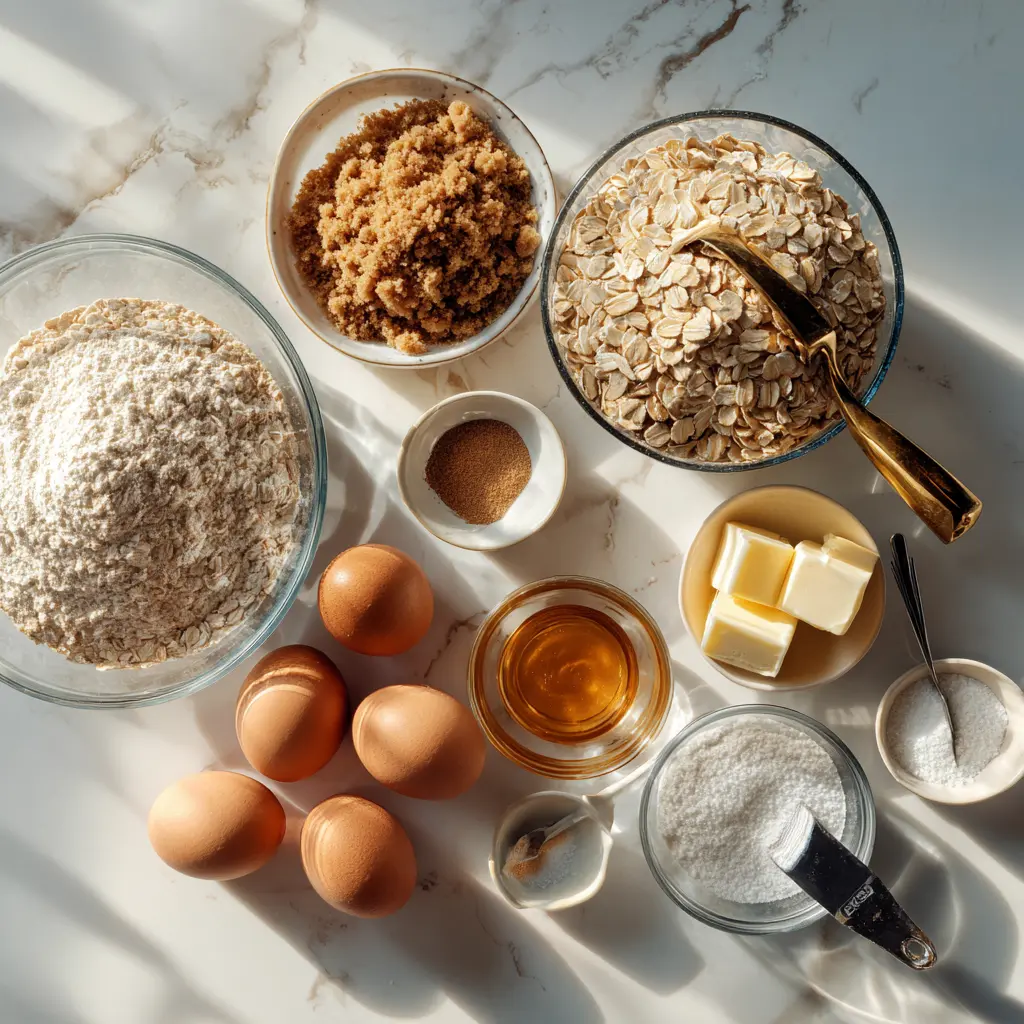
Oats: The Backbone of Chewiness
Every great oatmeal cookie starts with the oats. The type you choose has a direct impact on texture.
| Type of Oats | Texture & Best Use |
|---|---|
| Rolled Oats (Old-Fashioned) | Provide a hearty chew and visible oat flakes. Best for traditional chewy cookies. |
| Quick Oats | Absorb more moisture, leading to a softer, denser cookie. Less texture. |
| Steel-Cut Oats | Too tough for cookies; better for porridge. |
Chef’s tip: For the chewiest oatmeal cookies, stick with rolled oats. They give body and bite without drying out the dough.
Why Brown Sugar Makes Chewy Oatmeal Cookies Softer
Brown sugar is what makes a chewy oatmeal cookie truly chewy. The molasses it contains pulls in and retains moisture, giving your cookies a soft center and caramel-like depth of flavor.
| Sugar Type | Effect on Texture |
|---|---|
| Brown Sugar | Adds chewiness, moisture, and flavor depth. |
| White Sugar | Creates a crisper, drier cookie. |
| Mix of Both | Balances chewiness with a lightly crisp edge. |
Butter vs. Shortening: Choosing the Right Fat
The fat in your recipe plays a starring role in texture. Butter adds flavor and moisture but can cause more spreading. Shortening creates thicker, softer cookies.
| Fat Type | Effect on Cookies |
|---|---|
| Butter | Rich flavor and moisture; cookies spread more, leading to crispier edges. |
| Shortening | Higher melting point; creates thicker, softer cookies. |
| Butter + Shortening | Combines butter’s flavor with shortening’s structure for the best chewy balance. |
Chef’s tip: Many bakers prefer a blend of butter and shortening for the perfect chewy cookie that doesn’t flatten out.
Egg Yolks and Extra Moisture
Eggs aren’t just binders—they affect chewiness. Whole eggs provide structure, but adding an extra yolk boosts fat and tenderness.
| Egg Variation | Effect on Cookies |
|---|---|
| Whole Egg | Balance of structure and moisture. |
| Extra Yolk | Increases richness, fat, and chewiness. |
| Egg Whites Only | Leads to drier, firmer cookies—best avoided if you want soft chewiness. |
Cornstarch, Honey, and Molasses: The Texture Boosters
Sometimes, the smallest additions make the biggest difference. A spoonful of cornstarch softens the dough, while honey and molasses lock in moisture.
| Ingredient | Purpose in Chewy Oatmeal Cookies |
|---|---|
| Cornstarch | Tenderizes cookies and keeps them thick. |
| Honey | Adds chewiness and a floral sweetness. Use sparingly to avoid excess spreading. |
| Molasses | Deepens flavor, adds moisture, and enhances chewiness. Essential in classic oatmeal raisin cookies. |
The Science Behind Chewy Oatmeal Cookies
The Role of Fat: Butter vs. Shortening
Every baker eventually asks the same question: should I use butter or shortening? Butter delivers flavor and moisture, but it melts quickly, which makes cookies spread out thin with crisp edges. Shortening, on the other hand, has a higher melting point. That means your cookies bake up thicker, softer, and more uniform in shape. If you want the best of both worlds, use a mix: butter for flavor, shortening for structure.
The Role of Sugar in Chewy Oatmeal Cookies
Sugar isn’t just about sweetness—it shapes texture. Brown sugar, thanks to its molasses content, keeps cookies moist and chewy. White sugar, however, dries them out and creates crisp edges. That’s why many bakers lean heavily on brown sugar when making chewy oatmeal cookies, sometimes replacing part of the white sugar with molasses or honey to lock in even more moisture.
How Eggs and Moisture Affect Texture
Eggs act like the cookie’s backbone. The whites provide structure, but the yolks add fat and tenderness. For extra chewiness, slip in an additional yolk—it boosts richness without making the dough too runny. If you use only whites, your cookies will lean dry and firm, so always keep at least one yolk in the mix.
The Power of Baking Temperature and Time
Your oven is the final deciding factor in texture. Bake oatmeal cookies low and slow—around 325°F—for a softer, chewier bite. At 350°F, you’ll get the perfect balance: a chewy middle with lightly crisp edges. Anything hotter, and the cookies will brown too fast, leaving you with a crisper finish. The trick is to pull them out when the edges look set but the center still looks a little underdone. As they cool, they’ll settle into that perfect chewy texture.
Essential Ingredients for the Chewiest Oatmeal Cookies
Rolled vs. Quick Oats in Chewy Oatmeal Cookies
The oats you choose define your cookie’s personality. Rolled oats are the classic choice—they give that hearty chew and rustic texture that makes oatmeal cookies so satisfying. Quick oats soften the dough and create a smoother bite, but they can make cookies feel a little denser. Steel-cut oats? Leave them for your breakfast bowl. They’re too tough for cookies and will ruin that tender chew we’re after.
Flour Choices: All-Purpose, Whole Wheat, or Gluten-Free
Flour provides structure, but the type you use can shift the texture. All-purpose flour strikes the best balance between chewiness and structure. Whole wheat flour makes cookies heartier with a nutty flavor, but it can feel heavy if you use too much. For gluten-free bakers, a well-balanced blend works, but it usually needs a little help from binders like xanthan gum to hold the dough together.
Sweeteners: Honey, Molasses, and Maple Syrup
Liquid sweeteners add more than flavor—they bring moisture, too. A spoonful of honey adds chew and a floral sweetness. Molasses deepens flavor while giving the cookies a richer chew—this is why it’s the star of classic oatmeal raisin recipes. Maple syrup is softer in sweetness but adds subtle caramel notes that pair beautifully with oats.
The Secret Helpers: Cornstarch and Pudding Mix
Sometimes, the smallest tweaks make the biggest difference. A teaspoon or two of cornstarch softens the dough and keeps cookies thick and tender. Some bakers even stir in instant vanilla pudding mix, which adds extra moisture, flavor, and a gentle chew.
Chef’s note: If you want cookies that stay chewy for days, try combining rolled oats, brown sugar, and just a touch of molasses. That trio is pure magic.
Step-by-Step Guide to Making Chewy Oatmeal Cookies
Perfecting the Dough: Mixing and Chilling
Cookie dough is where the magic begins, and the way you treat it makes all the difference. Start by creaming your butter and sugars until the mixture looks light and fluffy—this step builds tiny air pockets that keep cookies tender. Mix your dry and wet ingredients separately, then bring them together gently. Overmixing will toughen the dough and rob your cookies of their chew.
Once the dough is ready, fold in your oats and add-ins—raisins, chocolate chips, or nuts—last. Then chill the dough for at least 30 minutes. Chilling firms the butter, prevents cookies from spreading too thin, and gives the oats time to hydrate for that perfect chewy bite.
If you’d like to see how classic oatmeal cookies come together, don’t miss the Classic Quaker Oatmeal Cookie Recipe—a timeless version that sets the foundation for every variation you’ll ever try.
Shaping and Spacing for Even Baking
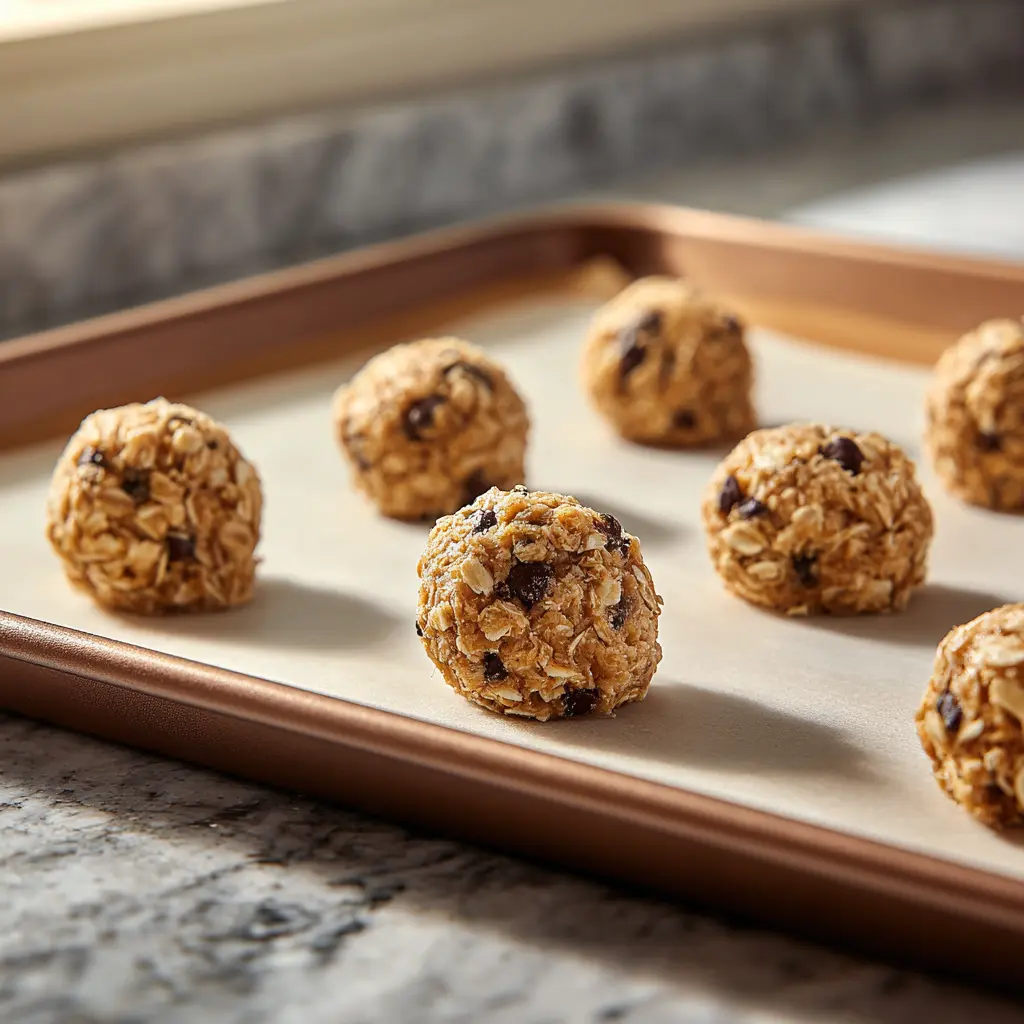
Shaping may seem like a small detail, but it’s the secret to consistency. Roll the dough into even balls using a cookie scoop—this ensures each cookie bakes at the same pace. Leave at least two inches between cookies on the baking sheet so they don’t merge into one giant cookie. For a thicker chew, keep the dough balls tall; for wider cookies, flatten them slightly before baking.
The Best Oven Temperature for Chewiness
The oven is where the alchemy happens. Bake your cookies at 350°F for 10–12 minutes for the perfect balance—soft, chewy centers with lightly crisp edges. If you prefer them extra soft, lower the temperature to 325°F and bake a little longer. Pull them out when the edges look set but the centers are still soft. Trust me, they’ll firm up as they cool, leaving you with that irresistible chew.
Cooling and Storing for Freshness
Don’t rush this step. Let cookies rest on the baking sheet for five minutes before transferring them to a wire rack. This keeps them from falling apart while they’re still hot. To store, place them in an airtight container at room temperature. For extra moisture, slip a slice of bread into the container—the cookies will absorb the humidity and stay chewy for days.
Common Mistakes and How to Fix Them in Chewy Oatmeal Cookies
Why Do Cookies Turn Out Flat?
One of the most frustrating problems is pulling out cookies that look more like pancakes than chewy bites. The culprit is usually butter that’s too soft or even melted before mixing. Warm butter makes dough spread quickly in the oven, leaving cookies thin and flat. Another common issue is skipping the chilling step—cold dough helps cookies hold their shape. Always use room-temperature butter, never melted, and chill your dough for at least 30 minutes before baking.
How to Prevent Dry and Crumbly Cookies
If your cookies come out crumbly instead of chewy, chances are you’ve added too much flour or baked them too long. Flour should be spooned and leveled, never packed into the measuring cup. And remember—cookies continue cooking for a minute or two on the hot tray after you pull them out, so remove them when the centers still look slightly underdone. Using quick oats instead of rolled oats can also dry cookies out, since they absorb more moisture. Stick to rolled oats if you want the best chewy oatmeal cookies.
What to Do If Cookies Turn Hard
Hard cookies are usually the result of overmixing or poor storage. Overmixing builds too much gluten in the dough, making cookies tough. Mix only until ingredients are just combined. For storage, always use an airtight container, and if your cookies feel too firm, tuck in a slice of bread. The cookies will draw in the moisture and soften overnight.
If you’re curious about experimenting with different fat ratios to improve texture, check out the Crisco Chocolate Chip Cookie recipe. It shows how shortening can change cookie thickness and softness, and it’s a great comparison point for oatmeal cookie dough.
Adjusting for High-Altitude Baking
Baking at high altitudes creates its own set of challenges. Dough can spread too much, or cookies can dry out quickly. To fix this, add a little extra flour for structure, reduce sugar slightly, and lower your oven temperature by about 15–25°F. These adjustments help keep the texture soft and chewy even when you’re baking above the clouds.
Variations and Flavor Combinations for Chewy Oatmeal Cookies
Classic Raisin Chewy Oatmeal Cookies
You can’t talk about chewy oatmeal cookies without mentioning the classic raisin version. Plump, juicy raisins pair beautifully with the nutty oats and warm spices like cinnamon. For extra chew, soak the raisins in warm water—or even a splash of rum—before folding them into the dough. That little trick keeps them soft and bursting with flavor in every bite.
Chewy Oatmeal Chocolate Chip Cookies
If you’re torn between a chocolate chip cookie and an oatmeal cookie, why not have both? Semi-sweet or dark chocolate chips melt into gooey pockets that balance the oats’ hearty texture. Some bakers take it further with brown butter, which adds a nutty richness. A sprinkle of flaky sea salt on top turns this variation into a bakery-level treat.
Nutty Delights: Walnuts, Pecans, and Almonds
For those who crave crunch with their chew, nuts are the way to go. Walnuts bring a hint of bitterness that balances sweetness. Pecans add buttery depth, while almonds give a firm crunch that pairs well with dried cranberries. Toasting the nuts before adding them to the dough intensifies their flavor and keeps them crisp inside the chewy cookie base.
Magical and Fun Twists
Cookies don’t always have to stay traditional. Try mixing in dried cranberries, coconut flakes, or even white chocolate chunks for unique flavors. For something whimsical, take inspiration from the Moon Spell Cookies recipe—it shows how playful flavors and creative presentation can transform a simple cookie into something enchanting.
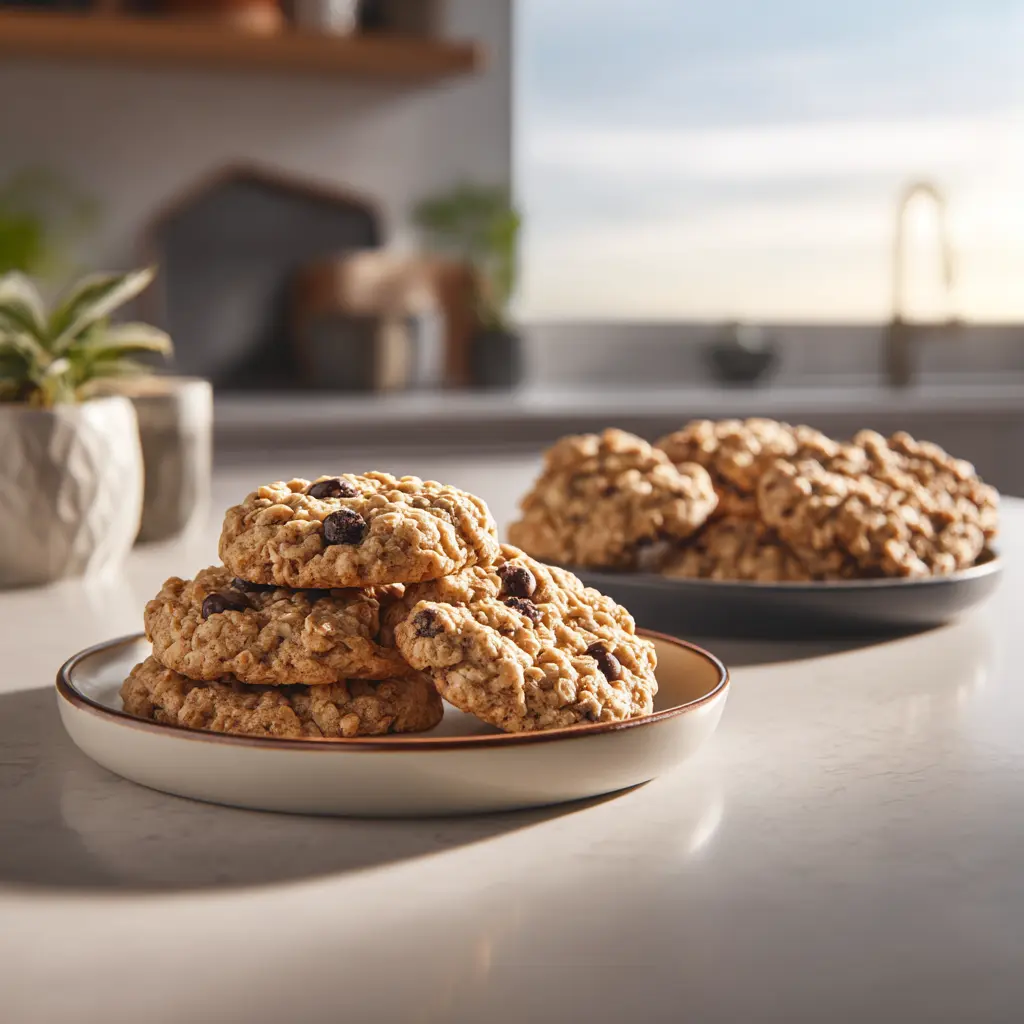
Healthier Twists: Vegan and Gluten-Free Options
Not everyone can enjoy traditional cookies, but that doesn’t mean they have to miss out on the chewiness. For a vegan twist, swap butter for coconut oil or vegan butter, and replace eggs with a flax egg. If you’re baking gluten-free, choose a certified gluten-free oat and a flour blend that includes binders like xanthan gum. The result? Cookies that are just as chewy, flavorful, and satisfying as the originals.
Baking Hacks for the Perfect Chewy Oatmeal Cookies
Chilling the Dough: Does It Really Matter?
Yes, chilling matters—a lot. When cookie dough rests in the fridge, the fats solidify, meaning the cookies spread less in the oven. The oats also have time to soak up moisture, which deepens flavor and improves chewiness. Even 30 minutes makes a difference, but overnight is ideal if you want cookies with bakery-level texture.
Using Browned Butter for Depth of Flavor
Brown butter adds a toasty, nutty note that elevates oatmeal cookies beyond the ordinary. To make it, simply melt butter in a pan and cook until golden brown with a nutty aroma. Let it cool slightly before mixing. The only catch? Brown butter reduces water content, so balance it by adding a splash of milk or an extra yolk to keep the cookies chewy.
Adding an Extra Egg Yolk
When I want oatmeal cookies that melt in the mouth, I sneak in an extra egg yolk. Yolks bring fat and emulsifiers that soften texture. They’re the secret weapon for cookies that stay chewy even after a few days in the cookie jar.
How to Keep Cookies Soft for Days
There’s nothing worse than baking the perfect batch of chewy oatmeal cookies, only to find them hard the next morning. The solution is simple: store them in an airtight container with a slice of bread. The cookies absorb the bread’s moisture, staying soft for days. And if you’re curious about another old-school baking hack that works wonders, check out the Easy Chocolate Bun Recipe—it’s another treat where proper storage keeps the texture just right.
FAQ About Chewy Oatmeal Cookies
What is the secret to chewy oatmeal cookies?
The real secret to chewy oatmeal cookies lies in the balance of ingredients. Brown sugar adds moisture, egg yolks bring tenderness, and rolled oats provide that hearty bite. Chilling the dough before baking also helps keep cookies thick and chewy.
Is butter or shortening better for chewy oatmeal cookies?
Butter gives chewy oatmeal cookies their rich flavor and a soft texture, but it can cause more spreading. Shortening creates thicker, softer cookies. For the best results, many bakers use a mix of butter and shortening to achieve the perfect chewy balance.
What makes cookies chewy vs. crunchy?
Chewy oatmeal cookies rely on ingredients that retain moisture—like brown sugar, honey, or molasses—while crunchy cookies usually have more white sugar and less fat. Baking temperature also matters: lower heat keeps cookies chewy, while higher heat makes them crisp.
Why are my oatmeal cookies not chewy?
If your oatmeal cookies turn out dry or crumbly instead of chewy, you may have overbaked them or added too much flour. Another common mistake is using quick oats instead of rolled oats, since quick oats absorb too much moisture. To keep them soft, stick with rolled oats and pull cookies out of the oven slightly underbaked.
What ingredient makes chewy oatmeal cookies soft?
Brown sugar is the MVP—it’s the ingredient that locks in moisture thanks to its molasses content. Egg yolks, cornstarch, and a spoonful of honey can also make chewy oatmeal cookies softer and more tender.
How do I make my cookies chewy instead of crunchy?
To make chewy oatmeal cookies instead of crunchy ones, increase the ratio of brown sugar to white sugar, add an extra egg yolk, and chill the dough before baking. Bake at 325–350°F and remove the cookies when the centers are still soft—they’ll finish setting as they cool.
Conclusion: Mastering Chewy Oatmeal Cookies
Making the perfect batch of chewy oatmeal cookies isn’t about luck—it’s about understanding the little details that change texture and flavor. From choosing rolled oats over quick oats, to balancing brown sugar with butter, every ingredient plays a role in creating cookies that are soft in the center, chewy at the bite, and rich in flavor.
Remember the golden rules:
- Use more brown sugar than white sugar for extra moisture.
- Add an extra egg yolk if you want maximum chewiness.
- Chill the dough before baking to keep the cookies thick and tender.
- Bake at 350°F and pull the cookies out slightly underbaked for the softest centers.
The beauty of chewy oatmeal cookies is that they’re endlessly versatile. Whether you prefer the classic raisin version, rich chocolate chip add-ins, or a nutty twist, the same principles apply. And don’t forget storage—an airtight container (with a slice of bread inside) will keep your cookies soft for days.
If you’re craving more cozy desserts after mastering chewy oatmeal cookies, you’ll love this Chocolate Pound Cake Recipe—a moist, rich treat that pairs perfectly with a tall glass of milk.
So preheat your oven, grab your favorite mixing bowl, and start experimenting. With the tips in this guide, you’re ready to bake chewy oatmeal cookies that taste like they came straight from a bakery—cookies that aren’t just a snack, but a story in every bite.

